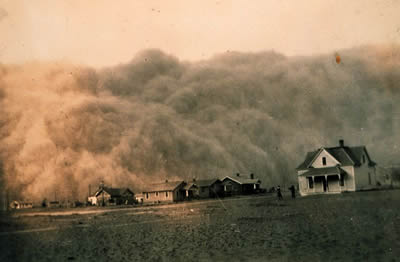Dust Bowl
I first became interested in the Dust Bowl when I watched the series Carnivale. That’s where I heard about dust pneumonia. I didn’t know that people got pneumonia from breathing in all the fine grains of dust in the storms. I began to understand that the weather wasn’t just breezy and dusty. Storms, like the one in the above photo taken in 1935, came out of nowhere.
Recently I read The Worst Hard Time by Timothy Egan. It’s a factual account of the Dust Bowl and the people who lived through it. Here’s a quote:
When the big roller crossed into Kansas, it was reported to be two hundred miles wide, with high winds like a tornado turned on it side. In Denver, temperatures dropped twenty-five degrees in an hour, and then the city fell into a haze. The sun was blocked. That was just the western edge of the storm. The front end charged into Kansas carrying soil from four states. Near the town of Hays, where Germans from Russia had settled fifty years earlier, a small boy who had been playing in the fields with a friend dashed for home. He got lost in the midday blackness; confused, he circled back. The next day he was found dead. He had suffocated, half a mile from home.
The book is fascinating on many levels. It focuses on a part of American history that I didn’t know much about. It shows how determined people can be to keep their homes. In a very understandable way the book details how World War One, wheat prices, weather patterns, the Depression and greed all came together to cause this tragedy.
It also made me think about global warming. Take another look at that photo. That’s what it looked like when people ignored the environment in the 1930s. What price will we have to pay for making similar mistakes?


Comments
Dust Bowl — No Comments
HTML tags allowed in your comment: <a href="" title=""> <abbr title=""> <acronym title=""> <b> <blockquote cite=""> <cite> <code> <del datetime=""> <em> <i> <q cite=""> <s> <strike> <strong>